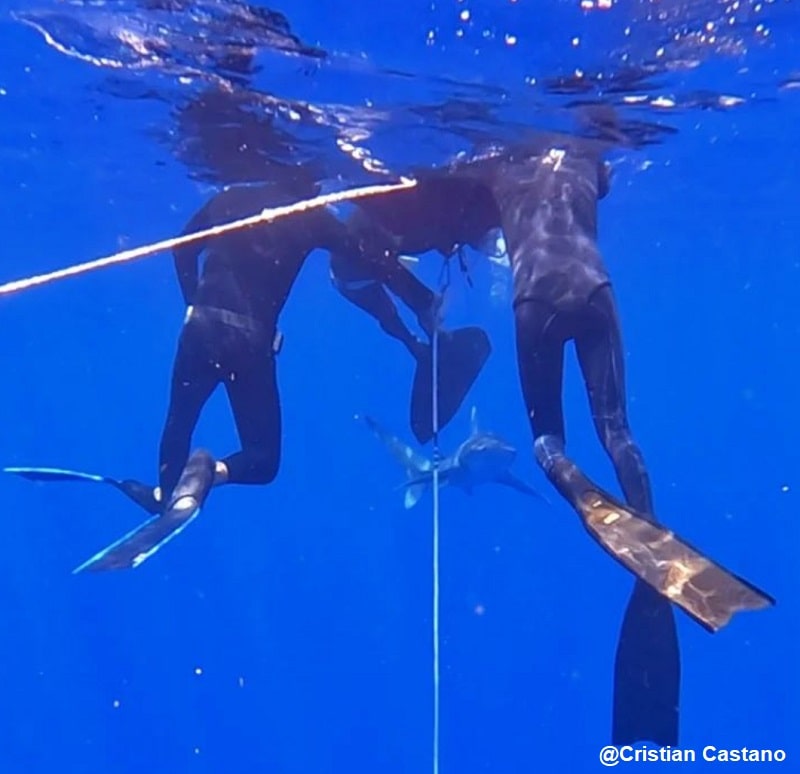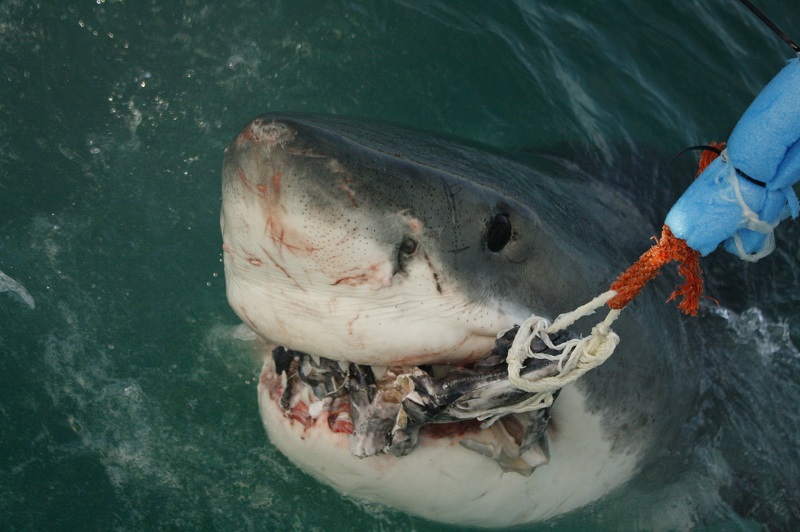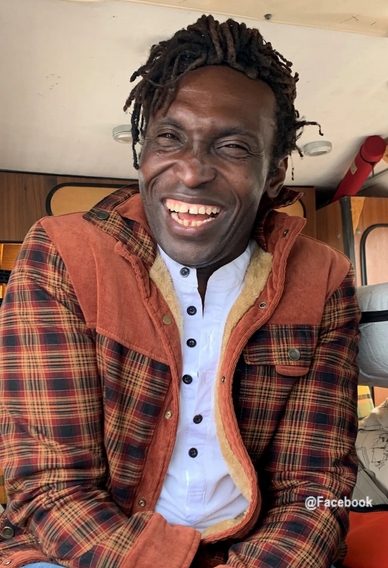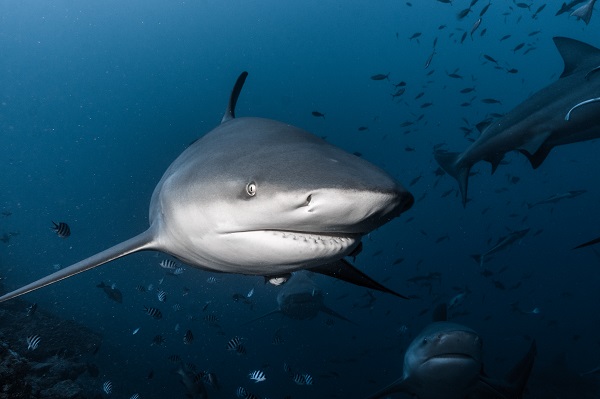A Colombian free diver is recovering after fighting off an Oceanic whitetip shark attack.
Cristian Castaño, 38, was depth-training July 18 with five dive partners near Nirvana off the southern archipelago of San Andres.
Castaño who holds 25 Colombian free diving records, was practicing holding his breath and descending in the 200 meter (656 ft) deep water.
With clear water the Nirvana dive site is an excellent practice area and is used for competitive freediving.
Castaño and his friends dropped two marker buoys with a long rope to act as a guide as they descended into the depths. They divided into groups of three per buoy.
“The shark came when we were at the surface. I was about to do a deep dive and we had a line at 80 meters (262ft) depth,” Castaño told Tracking Sharks.
The avid waterman was not overly concerned at first as he had seen several longimanus before and wondered if dropping the line could have drawn the shark’s attention. However, this interaction was different.
Around 11:30 the whitetip shark approached more closely than the others he had seen and, on its second pass, it began biting at the buoy.
“I was pushing him with the buoy traying to get in between the line and him, so he doesn’t get to me.”
Others in the group unhooked their buoys and began to swim away.
Castaño stayed behind the group in hope of keeping the shark away from his friends.

“I think he saw it as an opportunity to eat me and so he started attacking me,” he said. He was able to keep the shark at bay by kicking him with his fins.
“He kept coming and going away, coming and going away, until at one point he went past my fins and bit me.”
Castaño didn’t know where he was injured because he was too focused on keeping the shark at bay but did see blood clouding the water around him.
“Then he (the shark) got more aggressive and more intense because he saw that he could eat. He would pass my fins and I fought with him. I kept kicking him, punching him with my fists, I was looking for the eyes . . . I tried to stab him in the eyes with my fingers.”
During the ordeal, his dive partners splashed the water which attracted the shark as it swam to investigate the noise. When the shark came close enough to the group, they were able to punch it.
“I used that time to swim faster and go away, but I was feeling like I was going to black out.”
Castaño believes the fight lasted for 15 minutes, but admits he is unsure of the time, as his adrenaline was high. He estimates the dive group swam around 250 meters (273 yards) toward shore.
“I was losing a lot of blood in one of my arms,” he said. “I was trying to make a tourniquet with my hand to stop the bleeding from my right arm.”
Two divers spotted a boat and flagged it down.
“I was very lucky. When the boat came it was the moment that the other shark came, and I don’t think I would have survived two sharks.
“I was swimming backward keeping my eyes on the shark. Every time he came, I put my fins in his mouth or if he passes, I punch him and put my fingers in the eyes to try and make him go away. If it were two sharks, I don’t think I could have survived.”
The Good Samaritans picked up the divers and brought them to shore. Unfortunately, the only way to land was by a ladder attached to the rocky shore.
Castaño was unaware of the multiple injuries he’d received that exposed bone on his arms and leg until he climbed the ladder. He was taken by taxi to the hospital, and reports he was extremely thankful to hear no tendons or arteries had been severed.
“I think I am alive because I am very lucky, and I was able to hold my breath for a long time and keep my eyes on the shark.”
He is extremely thankful to the people on the boat who helped save his life by getting him out of the water and thanked his brave dive buddies for attempting to attract the shark to themselves. He credits the hospital staff with saving one of his arms.
“They were very, very nice and took a really good care with me.”
The attack won’t keep him out of the water, and he offers some advice for others who may encounter a shark.
“The first is not to go away from the group. I think being in a group together was protecting us better, so that was one mistake that I knew I shouldn’t have done.”
He is correct in that there is power in numbers, and sharks often target solitary prey.
Castaño also recommends those in open water carry something to defend themselves against sharks.
He advises taking “just sticks or a spear gun, not to shoot the shark but to keep it at some distance from you when it’s attacking. As for defending yourself with bare hands? Well, then you get all the wounds in your hands. Right? It happened to me.”
The attack has not changed his thoughts on sharks and he doesn’t hold a grudge against the shark either.
“We are the ones in their territory, and we have to be careful with the overfishing.”
He noted that hotels and cruise ships have been known to release food in the water, which attracts sharks closer to the island shores as they search for a meal.
Castaño is in good spirits while he heals and hopes to start training to compete in the Cyprus freediving competition.
“I invite people to learn free diving because it was a good skill. I mean, maybe the reason why it happened to me is because I was free diving, but also one of the reasons I survived is because I knew how to free dive. I was able to hold my breath while I kept my eyes on the shark, and while I swam away.
“I knew how to control my breathing as well. In my mind I knew not to black out, not to pass out from the bleeding. I manage with breathing and trying to keep calm, and these skills definitely I learned from free diving, so an invitation also for people to learn the sport that can be practiced in a really safe way. We were just in a really deep spot.”
The location has been marked on the 2023 Shark Attack Map.


